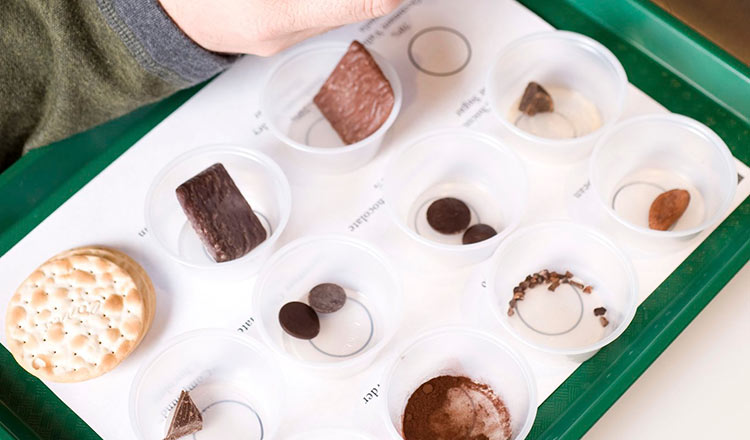Looking for a fun time with other food-minded friends? Or, do you just love chocolate and want to know everything out it? Consider a chocolate tasting! Like wine, chocolate is a multifaceted food, with each step of its growth and processing—from bean to bar—impacting its texture, flavor, and usability.
No label can tell you what a chocolate tastes like. All the consumer information in the world and carefully crafted written descriptions will not tell you how a chocolate tastes. Ultimately, chocolate is a food, and the best evaluation of it is how it tastes to you.
The range of flavor nuances created by different makers using different beans and different techniques is remarkable. Chocolate tasting has even become cause for a social event. You don’t need to be a super taster, or even a wine connoisseur, to taste and appreciate the different flavors found in chocolate and learn which ones most appeal to you. With a little practice and some comparison, you will soon be able to pick out many of the nuances that can be found in good-quality chocolate.
“Tasting chocolate” is a bit of a misnomer. It really is evaluating chocolate, and it involves all of the senses.
- Look at the chocolate. It should be shiny and uniform in color and texture. Any signs of bloom mean that the chocolate has not been stored properly. This chocolate may still be viable for use but cannot be used to evaluate a chocolate fairly.
- The sound and the feel are next: Break a piece of the chocolate; it should have a decided snap to it, both in sound and in a crisp, brittle feel.
- Now to taste: Put a piece of the chocolate in your mouth and allow it to melt for a few moments. Note how quickly or slowly it begins to melt.
- Chew the chocolate a few times, but leave the pieces on your tongue. This will release both the cocoa butter and the volatile flavor compounds. You will likely notice that the flavor changes during the tasting. Chocolates might start with a cocoa flavor note, and then might exhibit spiciness, followed by a fruity finish; or perhaps you will detect floral notes or acidity. There are no wrong answers, and practicing is fun.
- As the chocolate melts, take note of its smoothness. Good-quality chocolate should exhibit no graininess whatsoever; it should melt to a smooth luxurious velvet. Is it thin and fluid, or is it thick, maybe even gummy? Notice if the flavor is long lasting or fleeting.
A few key points about tasting chocolate:
- Limit any tasting session to no more than five different chocolates. If you try to taste more than this, your palate will be dulled by overexposure.
- If you are tasting several chocolates, begin with the lightest or the lowest percentage chocolate, and taste consecutively toward the darkest or highest percentage.
- Be sure that all chocolates to be tasted are at room temperature.
- Cleanse your palate between each tasting with water or a neutral-flavored bread or cracker.
- When comparing chocolates from different origins, try to get samples with the same cacao percentage so that they may be evaluated fairly.


